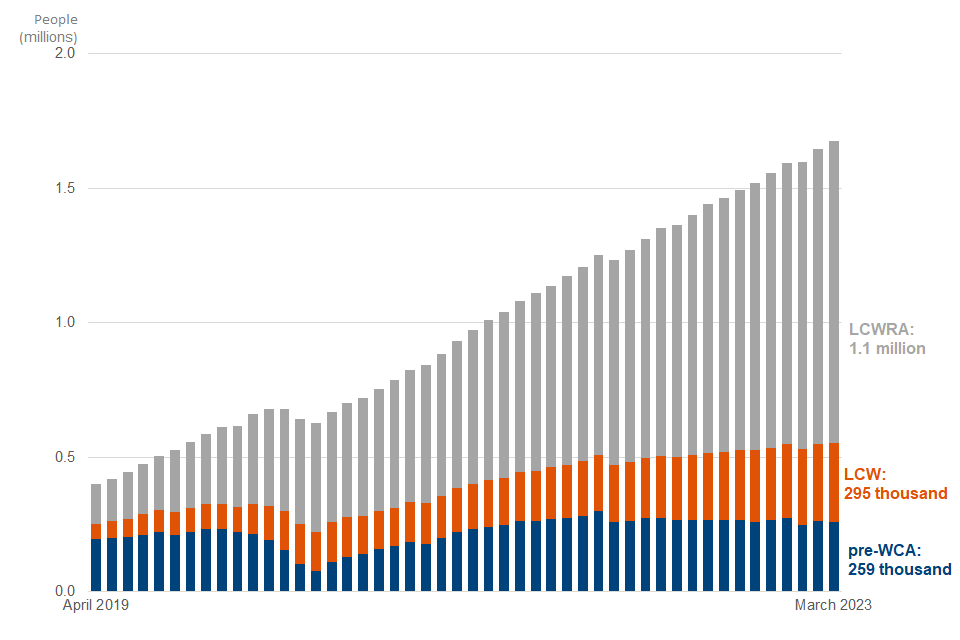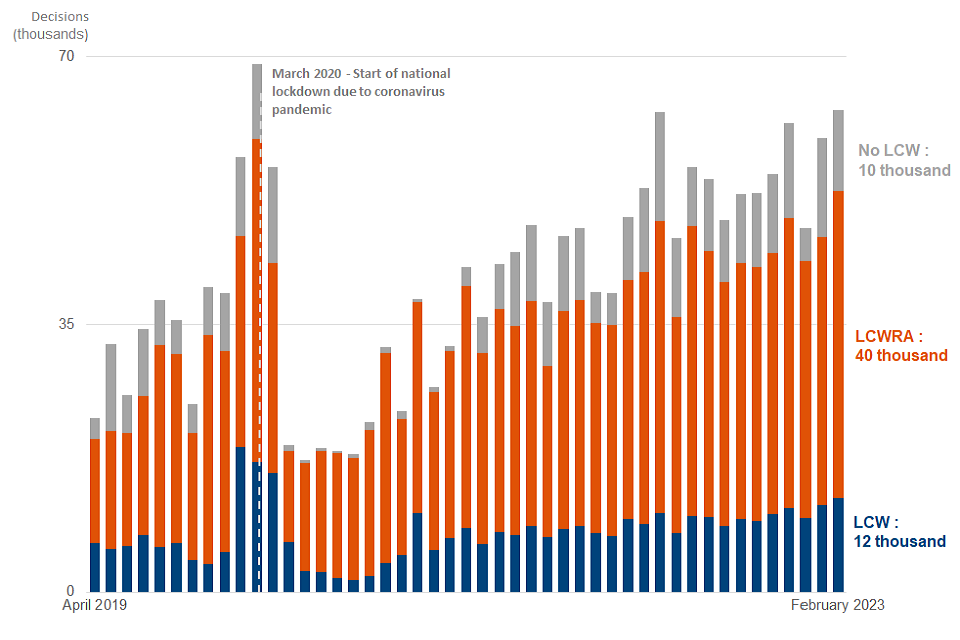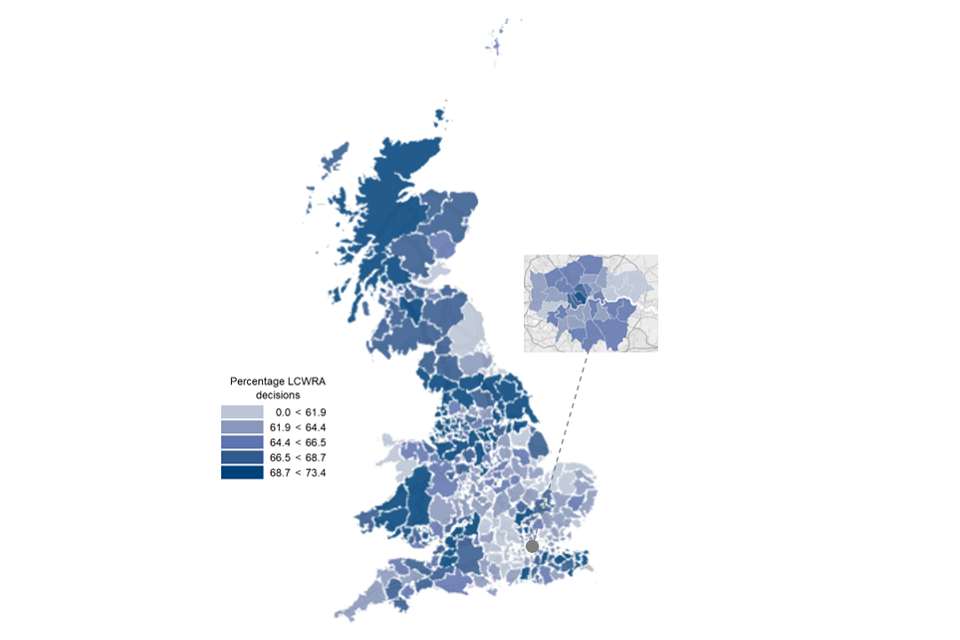Universal Credit Work Capability Assessments, April 2019 to March 2023
Published 8 June 2023
Applies to England, Scotland and Wales
The latest release of these statistics can be found in the Universal Credit Work Capability Assessment statistics.
This is the first release of experimental Official Statistics that detail:
- the number of people on Universal Credit (UC) with a health condition or disability restricting their ability to work,
- the number of Work Capability Assessment (WCA) decisions made for UC, and
- the outcomes of these WCAs
This is a new quarterly series of statistics, and the next release will be on 14 September 2023.
This release covers:
- the number of people on UC health from April 2019 to March 2023 – by stage of process and personal characteristics such as age and gender
- more granular information by region and local authority
- proportions of Universal Credit claimants on UC health
- monthly WCA decisions and outcomes from April 2019 to February 2023
Universal Credit has replaced income-related Employment and Support Allowance (ESA) for new claimants. The legacy ESA scheme closed to new claimants in January 2021. New Style ESA is a contributory benefit open to eligible claimants.
In some circumstances, Universal Credit can be claimed alongside New Style ESA. When both benefits are claimed together, Work Capability Assessments are led through the UC claim and outcomes then applied to both benefits.
1. Main stories
Caseload (number of people on UC health)
The statistics show:
- at March 2023, 1.7 million people were on UC health compared to 1.3 million a year earlier
- of these, 259,000 (15%) had acceptable medical evidence of a restricted ability to work pre-WCA; 295,000 (18%) were assessed as limited capability for work (LCW), and 1.1 million (67%) were assessed as limited capability for work and work-related activity (LCWRA)
- at March 2023, 52% were female, 38% aged 50 plus and 11% aged under 25
Proportions of Universal Credit claimants
The statistics show:
- in March 2023, more than a quarter (29%) of people on UC had a health condition or disability restricting their ability to work – up 5 percentage points from March 2022
- the region with the highest proportion of UC health cases relative to overall Universal Credit claimants is Scotland (36%), followed by Wales (35%) – and the lowest is London (22%)
UC WCA Decisions (in the period April 2019 to February 2023)
The statistics show:
- 1.9 million UC WCA decisions have been made. 16% of decisions found claimants had no limited capability for work and hence no longer on UC health, 19% limited capability for work (LCW), and 65% limited capability for work and work-related activity (LCWRA)
- the region with the highest proportion of LCWRA decisions was North West (69%) and the lowest the North East (59%)
- the proportion of decisions for LCWRA remained stable at 65% in the quarter ending February 2022 and 64% in the quarter ending February 2023
2. What you need to know
The number of people on UC health refers to those on Universal Credit with a health condition or disability restricting their ability to work. The sources of the statistics are:
- Department for Work and Pensions (DWP’s) Universal Credit full service administration datasets
- Healthcare provider assessment data
Statistics are published 3 to 4 months in arrears to allow sufficient time for retrospective data to be captured in the published statistics. Further information on the sources of the statistics and on their derivation is available in background and methodology.
Statistics include dual claimants of both UC and New Style ESA as well as both new and repeat UC WCA decisions. Statistics for each of these elements are not currently available.
All figures in this release have been rounded according to DWP rounding policy.
Status of the statistics
This release is classed as experimental statistics which are official statistics that are under development. The methodologies are in the testing phase and changes may be made. There can be a wider degree of uncertainty with experimental statistics, but this does not mean they are of low quality.
All official statistics comply with the Code of Practice for Statistics which makes sure official statistics are trustworthy, have public value, and are of high quality. The strengths and limitations of these statistics are explained in the background information and methodology document.
More information about experimental statistics is provided by the Office for Statistics Regulation.
Plan to remove the experimental label from these official statistics
This is a new quarterly publication as of June 2023. We would like to gather user views to guide our developments for at least 4 releases. As these are newly developed statistics, we are still testing the methodology to deliver improvements and make sure it is robust. The status of these statistics will be reviewed in summer 2024.
COVID-19 operational easements
Historic figures in this release reflect the disruptions caused by the coronavirus (COVID-19) pandemic, which led to changes in operational procedures. These changes were necessary to process claims and ensure people in need of financial help could access benefits, while keeping customers and staff safe.
DWP temporarily suspended face-to-face health assessments from 17 March 2020 while paper-based assessments continued, and telephone assessments were introduced from 7 May 2020.
Face-to-face assessments were resumed in May 2021, and they now take place alongside paper-based assessments, telephone assessments and a small number of video assessments.
3. UC health caseload by stage of process
Most individuals with a health condition or disability that restricts their ability to work, will have a Work Capability Assessment (WCA). The WCA determines whether a person has limited capability for work or work-related activity.
Monthly Universal Credit health caseload, Great Britain, April 2019 to March 2023
At March 2023, 67% of people (1.1 million) on UC health have limited capability for work and work-related activity.

Source: DWP Stat-Xplore, UC Work Capability Assessments
As at March 2023, 1.7 million people were on UC health – up 28% from March 2022.
Of those on the caseload as at March 2023:
-
259,000 (15%) had acceptable medical evidence of a restricted ability to work and were awaiting a decision
-
295,000 (18%) were assessed as limited capability for work (LCW)
-
1.1 million (67%) were assessed as limited capability for work and work-related activity (LCWRA)
The composition of the UC health caseload has changed over time as people migrated from ESA to UC, and due to the suspension of face-to-face assessments in March 2020 in response to the COVID-19 pandemic which adversely impacted DWP’s ability to complete assessments and for claimants to provide medical evidence.
Number of people on the Universal Credit health caseload by gender and age band, Great Britain, March 2023
There are more women on UC health than men, at every age band except 60+.

Source: DWP Stat-Xplore, UC Work Capability Assessments
At March 2023, 52% of those on UC health were female; 38% aged 50 plus and 11% aged under 25.
4. UC health caseload by region, local area and proportion of overall Universal Credit claimants
The region with the highest number of people on the UC health caseload is the North West – and the region with the lowest number is the North East. However, in terms of proportions of overall Universal Credit claimants, the picture is different.
Across Great Britain, the number of people on UC health represents 29% of the overall number of people claiming Universal Credit in March 2023 – up 5 percentage points from March 2022.
In March 2023, the region with the highest proportion of UC health cases relative to overall Universal Credit claimants is Scotland (36%). Wales has the second highest proportion (35%). London (22%) has the lowest proportion.
Proportion of Universal Credit claimants on UC health by region, Great Britain, March 2022 and March 2023
Scotland has the highest proportion of Universal Credit claimants on UC health in March 2023 - and London the lowest.
| Region | March 2022 rate (%) | March 2023 rate (%) |
|---|---|---|
| North East | 28.8 | 33.9 |
| North West | 25.8 | 30.7 |
| Yorkshire and the Humber | 25.0 | 29.9 |
| East Midlands | 23.7 | 28.3 |
| West Midlands | 21.6 | 26.7 |
| East of England | 22.5 | 27.1 |
| London | 17.5 | 22.2 |
| South East | 21.0 | 25.5 |
| South West | 26.2 | 31.1 |
| Wales | 29.4 | 34.9 |
| Scotland | 30.7 | 36.2 |
Source: DWP Stat-Xplore, UC Work Capability Assessments
At local authority level, Inverclyde (44%) has the highest proportion of Universal Credit claimants on UC health in March 2023, followed by Neath Port Talbot (41%).
Excluding very small local authorities where rates can be spurious, Newham (17%) has the lowest proportion of Universal Credit claimants on UC health.
Proportion of Universal Credit claimants on UC health by local authority, Great Britain, March 2023
Over a half of local authorities have between 20% to 30% of UC claimants on UC health.

Source: DWP Stat-Xplore, UC Work Capability Assessments
5. UC Work Capability Assessment decisions and outcomes
DWP decisions are based on the WCA outcome report from the Assessment Provider (AP) together with any related evidence. Decisions cover:
- limited capability for work (LCW) and required to participate in work related activity to help them move towards the labour market
- limited capability for work and work related activity (LCWRA) and therefore not required to undertake any interviews or work related activity
- no limited capability for work and therefore no longer on UC health
Monthly Universal Credit WCA decisions, Great Britain, April 2019 to February 2023
In the quarter to February 2023, 64% of UC WCA decisions were for LCWRA, similar to 65% in the quarter to February 2022.

Source: DWP Stat-Xplore, UC Work Capability Assessments
Since April 2019, DWP have made 1.9 million decisions.
Of these decisions, 16% of people were found to have no limited capability for work and hence no longer on UC health, 19% limited capability for work (LCW), and 65% limited capability for work and work-related activity (LCWRA).
The region with the highest proportion of LCWRA decisions was the North West (69%) and the lowest the North East (59%)
Proportion of LCWRA decisions by local authority, Great Britain, April 2019 to February 2023
All local authorities have more than 50% of decisions recorded as LCWRA.

Source: DWP Stat-Xplore, UC Work Capability Assessments
At local authority level, Chorley (73%) has the highest proportion of LCWRA decisions since April 2019, followed by West Lancashire (73%).
Excluding very small local authorities where rates can be spurious, Slough (55%) has the lowest proportion.
37 local authorities (10%) have more than 7 in 10 decisions recorded as LCWRA.
6. About these statistics
These statistics are badged as experimental Official Statistics in accordance with the Statistics and Registration Service Act 2007 signifying compliance with the Code of Practice for Statistics
Plans and proposals for further developments to the statistics are shown in the Release Strategy and summarised in the Statistical Work Programme
Key uses of the statistics include:
- providing the evidence base for assessing the potential effect of changes, monitoring and evaluation of DWP policy
- answering Parliamentary Questions and Freedom of Information requests and forecasting benefit expenditure (in conjunction with expenditure statistics)
- policy development and evaluation by local authorities and other welfare to work stakeholders and providers.
Where to find out more
This statistical bulletin gives an overview of the important points and trends. More detailed breakdowns can be found via the supporting data tables and DWP’s online tabulation tool Stat-Xplore.
Read more about UC statistics and ESA-WCA statistics.
See Transforming Support: the Health and Disability White Paper for information on proposed changes to support for those with health and disability needs.
Contact information and feedback
DWP would like to hear your views on these statistics. We would be interested in hearing what you use them for and how well they meet your requirements.
Feedback and queries about the statistics can be sent to [email protected].
Press enquiries should be directed to the DWP Press Office: 0115 965 8781. E-mail: [email protected].
Lead Statisticians: Ioana Criclevit and Russ Bentley
ISBN: 978-1-78659-515-7
